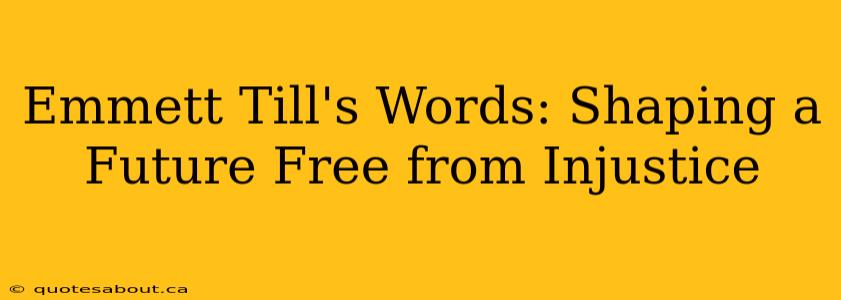Emmett Till's name echoes through history as a tragic symbol of racial injustice in America. His brutal murder in 1955, at the tender age of 14, ignited the Civil Rights Movement and continues to serve as a stark reminder of the insidious nature of racism. While Emmett himself never had the opportunity to fully articulate his experiences and fight for justice, the impact of his death resonated far beyond his short life, sparking crucial conversations and ultimately shaping the fight for equality. This article explores the unspoken words of Emmett Till and their lasting legacy in the ongoing struggle for a just and equitable society.
What did Emmett Till say before he died?
This is perhaps the most frequently asked question surrounding Emmett Till's story. Unfortunately, there's no definitive record of his last words. The circumstances of his kidnapping and murder were horrific, and any potential statements he may have made during this period remain unknown. What is powerfully impactful, however, are the implied words – the unspoken courage, the innocence brutally stolen, and the silent scream against the injustice he faced. These unspoken words fuel the movement for justice and equality to this day.
What did Emmett Till's murder reveal about racism in America?
Emmett Till's murder laid bare the deep-seated racism that permeated American society in the 1950s. The blatant disregard for his life, the ease with which his killers acted with impunity, and the subsequent trial that resulted in an acquittal exposed the systemic failures of the justice system to protect Black Americans. The photographs of his mutilated body, published in national magazines, shocked the conscience of the nation and the world, finally making visible the horrific realities of racial violence many had previously ignored or minimized. This event became a catalyst, exposing the brutality of Jim Crow and igniting a fire for social change.
How did Emmett Till's death impact the Civil Rights Movement?
Emmett Till's death was a pivotal moment in the Civil Rights Movement. The outrage it sparked fueled activism and helped galvanize support for desegregation and equal rights. His mother, Mamie Till-Mobley, made the courageous decision to have an open-casket funeral, allowing the world to see the gruesome reality of her son's murder. This act of defiance became a powerful symbol of protest, amplifying the call for justice and challenging the complacency of many. The subsequent attention generated from his case directly contributed to increased momentum within the movement. His story became a rallying cry, fueling the passion and determination of activists fighting for change.
What is the legacy of Emmett Till today?
Emmett Till's legacy continues to inspire activists and social justice advocates today. His name serves as a constant reminder of the ongoing struggle against racial injustice and the importance of fighting for equality. His story is taught in schools and discussed in communities as a powerful tool to educate and raise awareness about the past and the continuing challenges faced by marginalized communities. Emmett's unspoken words, his silenced voice, continue to resonate, urging us to confront the systemic racism that persists and strive for a more just and equitable future. His story is not just a historical event; it is a living testament to the enduring fight for civil rights and social justice. We must ensure his sacrifice was not in vain. We must continue to learn from his story and actively work to build a future free from the kind of violence and injustice that took his life.
Author's Note: This article aims to provide a comprehensive overview of Emmett Till's legacy. Further research into primary sources and historical accounts is encouraged to fully grasp the depth and significance of his story. The information presented here reflects widely accepted historical narratives and analyses.

